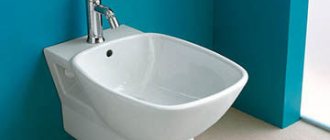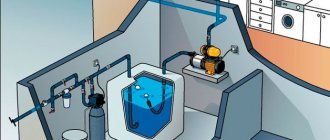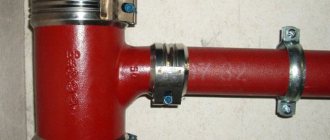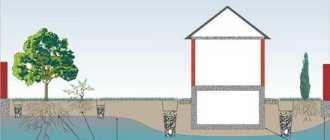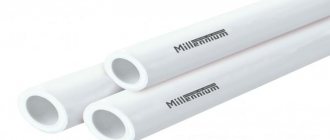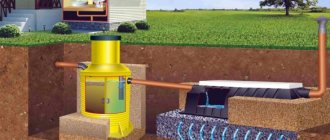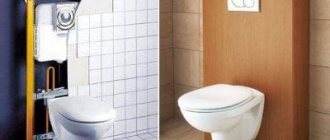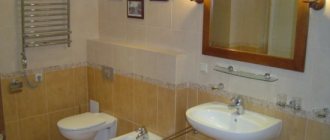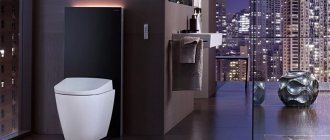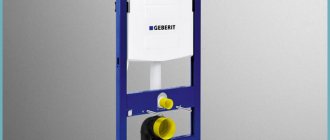The bidet installation is a modern special structural element based on a self-supporting frame.
This type of system, along with its components, is intended for the installation of hanging-type plumbing fixtures.
Let us consider in detail the rules for installing this structure.
What is an installation system and what does it consist of?
The installation system is a steel frame mounted on the wall, onto which fittings and a toilet (bidet, urinal) are attached. Such structures are covered with a false plasterboard wall, which creates a neat appearance.
Components of the installation for a wall-hung toilet:
- Steel frame - a metal frame with an anti-corrosion coating, onto which hydraulic piping and connecting components (fasteners, couplings) are fixed.
- A tank is a plastic reservoir for water intended for flushing. Supplied with a silicone or rubber drain valve gasket. The noise level of a modern flush cistern according to European standards does not exceed 17 dB.
- The flush button is the external part of the installation, which, depending on the type of system, may have two or one button, as well as additional options: “stop-flush” (stop the flush by pressing again), sensor (non-contact control).
Installation method
Installation of a bidet installation system
The right decision would be to entrust the installation to specialists. But even a person without special plumbing skills can cope with this work. Usually, before installation, pay attention to a number of important points:
- An installation diagram is prepared in advance, taking into account the existing bidet and mixer, as well as the location of the water supply lines.
- The frame is installed strictly according to the instructions, since this is a hidden installation design and access to it will subsequently be limited.
- Carefully check the reliability of the connections when connecting the installation to the water supply.
- Leave at least 35 cm between the toilet and the bidet to make the equipment convenient to use.
First of all, choose the installation location. Take into account that the sewer pipe approaches the bidet at a slope. The wall must be free of defects and the floor surface must be flat, otherwise the frame may become distorted. To install the frame, use the following tools: building level, screwdriver, hammer drill, pencil and tape measure.
Installation installation
Using a tape measure and a pencil, mark the locations of future holes for fasteners (2 on the floor, 2 on the wall). Periodically adjust the frame. Check that the marks on the floor and wall coincide with the mounting holes on the frame.
Drill holes in the marked places and, using the anchor bolts included in the kit, secure the frame to the floor and wall. Tighten the clamps located on both sides of the frame, which regulate the height of the bidet, then screw the holders of its bowl.
Connecting the device to the sewer
If water and sewer pipes are not suitable for the installation site, they will have to be installed. They are connected through special fittings with threaded couplings located between two vertical posts. Fittings are screwed into the couplings, which are connected to the sewerage and water supply.
When connecting communications, it is important to ensure the reliability and tightness of the connections. The gaps between the couplings and fittings are treated with sealant, and fum tape or flax is wound around the threaded connections. Cold pipelines are sometimes insulated to subsequently avoid the formation of condensation.
The pipes should not come into contact with the frame. To do this, you can put a polystyrene foam pad between them. To keep them in a stationary position, fixing them with clamps is suitable. If your bidet faucet is equipped with an electronic mechanism, you will have to think about providing an electrical supply.
Bidet installation and frame cladding
The mixer is connected to the water pipes, and the siphon and outlet pipe are connected to the sewer. In this case, the mixer body is left behind the fittings, and the control mechanism is brought out through a special hole. A power cable is additionally connected to the electric mixer.
The bidet is fixed to the frame with special pins included in the installation package. The studs are attached at a distance of 18 or 23 cm from each other. This value depends on the size of the bowl. The height of the device is set arbitrarily, but not more than 43 cm.
The final stage is disguising the bidet installation. In this case, there are two options - plastic panels that hide the entire wall, or a plasterboard box that will hide only the structure itself. Then the finishing cladding is performed - pasted over with tiles or other materials. The main thing to remember is that access to communications will be closed. Therefore, it is worth thinking about the plumbing hatch in advance. It will come in handy when the system needs repair.
Pros and cons of systems
Like any other plumbing fixture, installation systems have pros and cons. Characteristic positive aspects include:
- Rational use of usable space: installing a wall-hung toilet requires less space than standard compacts.
- Visually enlarges the room and improves design aesthetics: without a tank, there is no feeling of a clutter of objects, and all technical elements remain hidden in the wall.
- Hygiene: wall-hung toilets do not have a foot where bacteria accumulate, and the space underneath remains free, which makes cleaning underneath much easier.
- Low noise level: the false wall is an additional soundproofing layer that reduces the noise of the tank.
As for the disadvantages of using installations, they are as follows:
- Installation of the structure is more complicated compared to a conventional compact toilet. It will require careful measurements and consideration of technological features.
- The cost of wall-hung toilets complete with installation is significantly higher than traditional floor-mounted plumbing fixtures.
- Installing a false wall makes it difficult to access central communications, which complicates repairs if they leak or need to be replaced.
What is it for?
Using a bidet installation allows you to install the equipment in almost any area of the room, provided that the necessary communications can be connected to the system. However, you need to remember that despite the wide installation possibilities, it is still best to install the bidet in close proximity to the toilet and preferably at the same level with it.
The installation allows you to use the space as efficiently as possible - all pipes can be hidden behind the decor
Another advantage of using the installation is significant space savings, achieved due to the fact that all communication systems are hidden behind the decor of the structure. At the same time, special repair windows allow access to all elements of equipment.
Myths about hanging plumbing
There are popular misconceptions regarding the installation and use of wall-hung toilets:
- Installation of the structure will require a lot of space due to the need to install a false wall. This is wrong. Since the installations are mounted directly on the wall, the space required to install a wall-hung toilet is the same as to install a traditional compact cistern.
- To repair problems with water supply or drainage, you need to disassemble the wall. We hasten to please you - you won’t have to touch the outer cladding. You can get the parts of the tank through the flush button. It serves as an inspection window.
- Hanging sanitary ware cannot support heavy weight and is not suitable for large people. This is also a myth, since according to the standard, installations must withstand weights of up to 400 kg, and some models are designed for loads of up to 600 kg.
Connecting the bidet to water supply and sewerage
To connect the product to the water supply system, you need to consider the type of device:
- The floor-standing model is connected by screwing the nut of the flexible connection to the tee of the water pipe;
- When connecting a suspended model, this nut is screwed onto the frame of the pipes.
Connection to the sewerage system
The process is very similar to connecting a conventional washbasin and consists of the following steps:
- The rubber cuff is installed in the socket of the sewer pipe. To prevent the gum from drying out over time, it can be lubricated with silicone sealant.
- It is also necessary to lubricate the end of the outlet corrugated hose connected to the siphon with sealant.
- The last step is to insert the corrugated hose into the collar of the sewer pipe socket.
Types of installation systems and features of their installation
The block installation consists of a cistern, a key and fasteners. Such systems can only be installed on load-bearing walls. An existing niche is well suited for installation, provided the dimensions match. If the system is installed without a niche, then the space under the tank is filled with bricks. In this case, the toilet is mounted separately.
Frame installation, due to the presence of its own support, does not require a main wall for installation. Structures can have three methods of fastening:
- Wall-mounted: mounted on a horizontal surface (but with a load on the floor due to the legs).
- Floor-mounted: with mounting only on the floor without connecting to the wall.
- Combined: with fastening at two horizontal and two vertical points.
Corner installation is a type of frame structure with additional overlays at an angle of 45 degrees - two at the top and bottom, and a triangular-shaped tank. Suitable for combined bathrooms, where every centimeter of space counts.
Low installation is suitable for installing a toilet under a window or in other cases when there is not enough space to install a standard model.
The height of such structures does not exceed 82 cm.
Installation of the installation frame
There are several basic rules that must be followed regardless of the design features of the installation frame:
- the process of installing a frame structure must begin with high-quality leveling of the floor surface;
- the block structure is fixed on the wall, and the frame installation is attached not only to the wall, but also to the floor;
- it is necessary to adjust the location of the fasteners in height using retractable legs, which allow you to raise the frame by 40 cm;
- the depth of the location of the frame structure should be adjusted using special extensions that allow you to change the initial position by a maximum of 18 cm;
- block structures are “hung” on the wall with a preliminary selection of the mounting location and alignment of the level of the plumbing fixture;
- the frame or block structure must be fixed using anchor bolts, which are screwed into pre-drilled holes;
- The dimensions of the fastening elements must be selected in accordance with the weight of the plumbing fixture, as well as taking into account the maximum permissible load during operation.
Installation drawing
Thus, the process of preparing for installation of the structure includes leveling the surface, marking the points for screwing in the anchors and drilling holes for fasteners in accordance with the markings.
The main stages of installation are fitting the frame and temporary fixation with anchors, adjusting the position of the structure using extensions and legs, as well as finishing anchor bolting.
Since a bidet is not the most common household item, not everyone knows how to install it correctly. You can install the bidet yourself. Read the instructions and do everything in order.
Bidet lid – see this review for functionality and types.
What types of shower heads there are for a hygienic shower and which one is better to choose, we will tell you in this article.
Selecting an installation by size
Installation systems from various manufacturers have standard dimensions: width 50 cm, depth 10-15 cm, height - up to 1 m - for block structures, width 50-60 cm, depth - 15-30 cm, height - 0.8-1.4 m - for frame systems.
For certain conditions, a number of manufacturers offer non-standard modifications - low and angular. A mandatory option for low partitions is the ability to position the flush plate not only frontally, but also in the upper part of the frame plane. Compact equipment can have a depth of up to 8 cm, but it must be taken into account that in this case the volume of the drain tank will be small.
Top best companies and installations for bidets
There are a sufficient number of companies in this market that strive to win the trust of consumers by offering various models and unique devices of plumbing equipment.
The most famous players in this sector:
- Cersanit.
- Grohe.
- Geberit.
- Alcaplast.
- Vidima.
The company that has a dolphin on its logo is a Polish brand called Cersanit. The company was founded not so long ago - in 1998. It mainly produces ceramic products and components for their installation.
Grohe is a company originally from Germany (Dusseldorf), whose products are known on the domestic market and are of very high quality. This is no wonder - the brand was founded in 1936. The products of this company are of high precision and recognized quality (taps, fittings, locking elements, mixers, and other products). The company's products are not only sold at retail, but are also popular with construction giants who equip their facilities with this equipment. The share of sales in the overall market is about 8%.
Geberit – the brand was originally created in Switzerland, its history goes back over 100 years. The company constantly introduces new developments and specializes mainly in flushing systems. Currently, the total number of factories is 17, they are located in Germany, Italy, the United States, Slovenia, Austria, China and Switzerland.
ALaplast's homeland is the Czech Republic, and Vidima brand products are manufactured in Bulgaria. Both of these brands have affordable prices, good quality and offer a wide range of plumbing equipment.
The best installations for wall-hung toilets with floor loading
The installation is mounted on the wall and serves to hold wall-hung versions of toilets, while the metal structure itself can experience different loads. In addition to the toilet, she also has to hold a filled tank, not to mention part of the human weight. Therefore, they try to use installations that can be installed against the wall. Then the overwhelming majority of the weight falls on the floor. The legs of such installations are very wide, and the frame is reinforced. Below are the installation models that buyers choose most willingly.
1. Cersanit Delfi S- Set- Delfi/ Leon/ Cg- w – it has a simple design and is quite durable.
This option contains all the necessary elements to allow for suspended mounting. The frame is made in the form of a rectangle with a crossbar (where it is necessary to fix the toilet). Wall mounting is carried out with two studs in the upper part and one in the center. The legs are adjustable (retractable) and are secured with clamps.
The installation kit includes a toilet bowl, as well as a flush button, which can perform both full and partial flushing. The kit contains a circle and a seat, and there is also an adapter that allows you to connect an 8 cm toilet neck with a 10 cm diameter sewer. The frame is not too wide (3.5 cm), making installation possible for different niches. To install, you do not need to purchase anything beyond the kit.
Pros:
- affordable cost;
- presence of all required elements in the kit;
- small frame width;
- wide range of vertical adjustment;
- The kit already contains a toilet.
Minuses:
- the drain button is not very reliable - after some time it gets blocked and does not allow itself to be pressed;
— the seat is located at least 0.5 m from the floor;
— the number of hairpin threaded turns is very small;
— poor response of the bidet seat.
2. Model Geberit Duofix 111.300.00.5 is suitable for those with a significant weight.
The creators of this product envisaged the use of the installation for people with significant weight. The frame is reinforced and has a thick profile, making the racks really durable. In addition to the jumpers at the top and bottom, there is a reinforcement element (a wide pipe with a rectangular profile). It is located at the toilet mounting level. The legs are made to move out, and they are galvanized to prevent rust. The legs also have plate stops and holes for mounting. This design is designed for a person’s weight up to 150 kg.
Recommended articles on this topic:
- Arrangement of a small apartment
- Stages of renovation in an apartment
- Turnkey cosmetic repairs
The bidet model is equipped with a tank that holds 6 liters of water and allows you to release this volume or half of it (depending on which part of the button is pressed). There is also a flush elbow and a pipe for water supply. The frame is powder coated. Frame dimensions – 5 cm (width), 1.12 m (height).
The installation can be mounted in front of a blank wall and disguised using drywall. But you can install the product behind the load-bearing support. You can also install a frame between non-permanent partitions, because the main load is borne by the legs (their length is 20 cm).
Pros:
- The manufacturer provides a ten-year warranty on the drain tank;
- no seams on the tank;
- durable frame that can withstand heavy loads;
- high quality workmanship;
- ease of installation;
- corner mounting option.
Minuses:
- small selection of keys;
— difficulty of service in case of breakdown;
— the vertical size of the frame (1.12 m) narrows the possibility of installation in many niches, at the bottom of shelves.
3. Grohe Rapid SL 38750001 - an excellent option for retail centers and offices.
The creators of this installation managed to combine strength and high mounting versatility. The profile pipe firmly holds the tank (by the way, its volume is 9 liters), as well as the weight of an average person and the toilet.
The peculiarity of this design is the ability to connect in different ways. The eyeliner can be done from the back, left or right. The design supports row and single use. This feature makes the installation very convenient for an office or shopping center.
Water drainage can be performed in three ways: quick (start/stop), volumetric and constant (used for cleaning). In this model, you can vary the connection depth, the distance between the bowl and the frame, as well as the mounting height. The product includes a decorative panel and a window for maintenance. The kit contains a gasket to isolate noise when filling the tank.
Pros:
- reliable metal construction;
- sufficient variability of connection;
- quiet filling of the tank;
- economical water consumption;
- powder coating of frame;
- pneumatic key included in the kit;
- protection against condensation.
Minuses:
— small window size for maintenance;
— the chrome layer on the flush key wears off over time.
4. Wisa 8050.435051 – everything you need.
This installation for a bidet was created in Holland. The system has all the elements for installation in a bathroom. The kit is quite expensive, but it includes everything you need - a toilet, mounting frame, cistern, flush key, and a full set of hoses. The manufacturer has supplied the kit with two gaskets - one serves to isolate noise between the wall partition and the toilet; the second is a decorative element covering the maintenance window.
The installation frame is quite narrow - 38 cm. However, this allows you to place the products in the usual niches allocated for pipes. As a result, space in the bathroom is saved, and the false wall deep into the room can be extended to the minimum.
The kit includes a tank with a capacity of 6 liters. The toilet is made of ceramic and is included in the kit. Its dimensions are 53 * 36 * 44.5 cm. The manufacturer provides a 10-year guarantee for all elements of the set.
Pros:
- the toilet is already included in the kit;
- 10 year warranty;
- small frame width;
- suitable for all sizes;
- workmanship;
- chrome flush key;
- smooth drainage around the entire perimeter.
Minuses:
— large weight of the structure;
— it is not easy to find the membrane in case of breakdown;
— the gasket at the toilet connection tends to come out.
What types of flush systems are there?
- Mechanical drive. It works by analogy with the fittings of a standard flush tank, where the release of water is activated through a pusher driven by pressing a button. This is the simplest and most reliable flush unit.
- Pneumatic drive. The release of water is activated by the displacement of compressed air from the reservoir moving through a flexible tube. The main advantage of this flush mechanism is the possibility of placing the flush button at a distance of up to 2.5 meters from the installation and its horizontal installation.
- Electronic (touch) drive. It is driven by the sensor's response to touching the panel or to a person leaving the restroom. The first flushing method is usually more convenient, since you often have to use a brush during the process. The downside of the system is its high cost.
Also, additional options may be provided in drainage systems, for example, a flush-stop to stop draining water, or, conversely, a continuous flush function, when the flow of water does not stop automatically, but can only be stopped manually.
It is important that the flush button can be purchased separately from the installation, while implementing all the necessary functions and choosing not the standard, but the desired design of this visible part.
Our gallery of works
Types of installation devices
The main purpose of the installation is to ensure reliable fastening of the wall-mounted toilet. Its use also allows you to hide all communications, the drain barrel from view, and use additional equipment, such as a system for saving water supply for drainage. The cost of such models is not small, and therefore it is better to give preference to products from trusted manufacturers: German, Swiss. Installing the unit together with floor equipment most often serves purely aesthetic purposes and, as a bonus, makes it easier to sanitize the room.
The choice of installation should be based, first of all, on the features of its design. There are 2 types of products: block and frame. The first ones are attached to a load-bearing wall and are suitable for use with any type of toilet. The latter have variable fastenings: to the wall and floor, which makes the presence of a solid wall optional. They are considered the most durable and reliable.
Options for the location of installations in the interior
As for the installation of installations in the interior, in addition to standard designs that require no restrictions on the size of the room for installation, there are the following options:
- Double-sided installation - used to hang plumbing equipment on different sides of the wall. Mainly used in public spaces - offices or shopping centers, but can also be used in country houses or cottages.
- Linear installation is a single installation structure for installing several plumbing fixtures at once - toilet, sink, bidet, urinal - on one wall. Allows you to install all plumbing fixtures in one go.
- Corner installation allows even corners to be used rationally in small rooms. To implement the idea, you can buy a special mounting kit or special mounts for placement in the corner of a standard module.
- Low installation - used to place the toilet under a window or in a separate partition created for this purpose. The height of such a frame structure does not exceed 82 cm.
Typical bidet installation mistakes
- To operate effectively, the sewer system must have a certain pipe slope. It should be taken into account that when laying a pipe from the sewer riser to the installation site of the equipment, the angle of inclination of the section should be about 15° or from 3 to 5%. These requirements must be observed when rearranging all types of plumbing fixtures (sinks, toilets, bidets, showers, etc.). If you need to move the drain of any equipment from the riser to 2 meters, then it will have to be raised by 60–100 mm.
- To connect to the sewer riser, you need to provide convenient access to the siphon connection point to the sewer joint and the drainage point.
- Check for sewer slope when installing the bidet. The water should flow by gravity into the drain hole. The sewer system must be completely sealed.
- Incorrect adjustment of the mount may cause it to tilt to the side.
- Do not install the bidet on an uneven surface or fix the bowl loosely.
- Silicone sealants are used to seal the gap between the wall and the bowl of the hygienic device.
- At the points where the siphon connects to the drain or sewer, traces of leakage may appear. In this case, you need to check the integrity of the siphon and seal the joints with sealant.
Recommended installation schemes
The bidet installation is mounted according to one of the existing installation schemes:
• on a separate frame;
• on a frame common with the toilet;
• for angular modification of the frame.
Experts recommend giving preference to a separate frame. The principle of operation is to supply cold and hot water to the bidet. The mixer on the bowl makes it possible to use liquid at a comfortable temperature when performing hygiene procedures. More expensive designs are equipped with an automatic temperature control system.
Types of bidets
A bidet is a sanitary device that allows you to comfortably carry out intimate hygiene procedures. The appearance has almost the same shape as the toilet. This makes it possible to decorate the interior of the bathroom in a single style.
There are several types of bidets, which differ in design features.
• Floor-mounted – represent the classic version with fastening to the floor. Glue or bolts are used as fasteners, sometimes a combined connection is made. Based on the principle of operation and installation technology, a floor-mounted bidet is no different from conventional toilets.
• Suspended – more compact, fastening to the floor is not provided. The structure is installed at a convenient height and supported by an installation hidden behind a camouflage screen. The installation kit is selected to be the type intended for a bidet. This bidet model is installed together with a wall-hung toilet, which requires the arrangement of two installations. In this case, it is worth considering that the paired design requires a lot of space.
The range of bidets is so wide that there will be no problems with choosing a color or shape. Manufacturers produce plumbing fixtures in stylized collections. Therefore, emphasizing or supporting the Provence, high-tech, modern style in the interior of the bathroom will not be difficult.
Advantages of modern installations
The first thread on the forum, dedicated to mounting frames, dates back to February 2011; naturally, the simplified designs of the first generation (for our country) and modern ones are two big differences. Today it is not just a “bare” frame with technical holes for fasteners and components, but a convenient and practically assembled “constructor”.
Sergey VitreshkoChief technical specialist at Viega for Russia and the CIS countries
The new system for wall-mounted plumbing has been developed on the basis of many years of practical experience and advanced technical solutions. Simplicity, ease of design and installation: the system can be assembled with virtually no tools, and at the end users are provided with complete comfort. For convenience, the possibility of both “dry” and “wet” finishing (with lining) is provided. The innovative range includes:
- mounting profiles;
- facing panels;
- modules for wall-mounted fixation of suspended plumbing equipment without lining;
- Concealed installation blocks with lining.
One of the most important elements of the installation is the tank.
AlekcaMODERATOR FORUMHOUSE
In principle, an “installation” is a product consisting of a metal frame and a concealed tank mounted on this frame. Therefore, the quality of the design must be judged by these parts. The frame itself can be much to be desired with elements of fixation in height and to the wall. For example, with well-known brands, the frame is universal for installation on a main wall, frame partition, options for openings for the receiving sewerage...
Sergey Vitreshko
For complete compatibility and simplified installation, both dry and with lining, the main component of the innovative system is a universal flush tank - one for all modifications within the line. It can be installed without tools and is compatible with all flush plates.
Regardless of brands, modifications and design features, the control element - buttons (panels) - always remain visible. And this is the case when decorativeness goes hand in hand with functionality and both parameters need to be evaluated. As in conventional toilets, in installations the buttons are either dual-mode or full flush. But if classic tanks are equipped with only the simplest pneumatics, then installations also have touch controls. Moreover, there are not just a few variations to choose from, but many.
Sergey Vitreshko
To select an individual flush button for a toilet or urinal, it is convenient to use the button configurator - a choice of more than fifty different flush panels (for toilets and urinals).
Conclusion
The advantage of modern installations is ease of installation - the system for wall-mounted plumbing is assembled practically without the use of special tools. And wall-mounted plumbing in general is both aesthetically pleasing and practical.
In previous materials you can read about choosing a toilet and the correct wiring of communications in the bathroom. For the originals - how to make a sink from tadelakt. The video contains a master class from an experienced plumber on installing water supply in an apartment.
Subscribe to our Telegram channelExclusive posts every week
